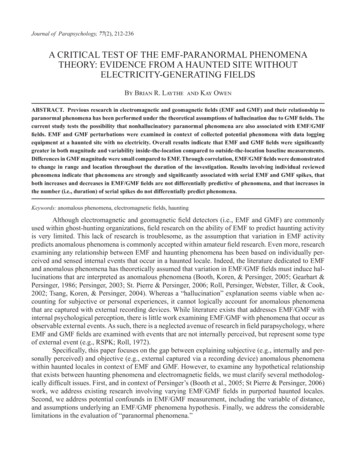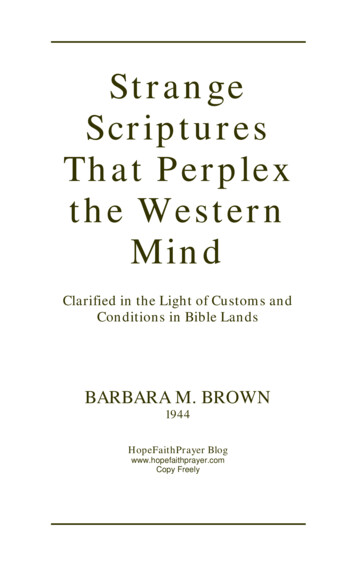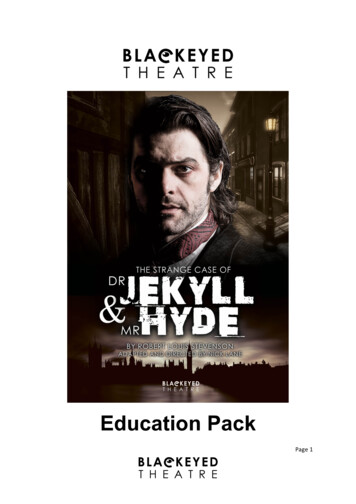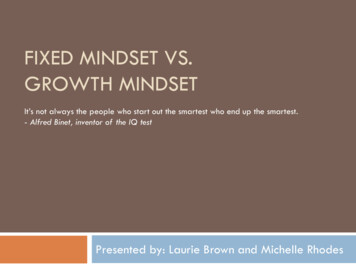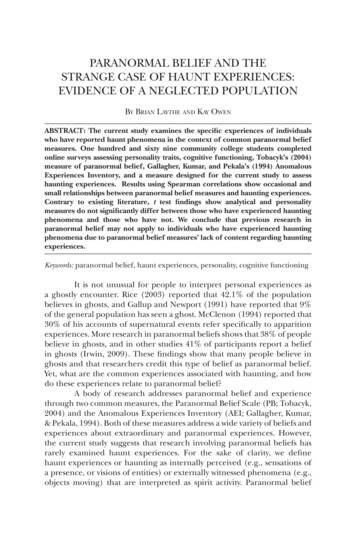
Transcription
PARANORMAL BELIEF AND THESTRANGE CASE OF HAUNT EXPERIENCES:EVIDENCE OF A NEGLECTED POPULATIONBy Brian Laythe and Kay OwenABSTRACT: The current study examines the specific experiences of individualswho have reported haunt phenomena in the context of common paranormal beliefmeasures. One hundred and sixty nine community college students completedonline surveys assessing personality traits, cognitive functioning, Tobacyk’s (2004)measure of paranormal belief, Gallagher, Kumar, and Pekala’s (1994) AnomalousExperiences Inventory, and a measure designed for the current study to assesshaunting experiences. Results using Spearman correlations show occasional andsmall relationships between paranormal belief measures and haunting experiences.Contrary to existing literature, t test findings show analytical and personalitymeasures do not significantly differ between those who have experienced hauntingphenomena and those who have not. We conclude that previous research inparanormal belief may not apply to individuals who have experienced hauntingphenomena due to paranormal belief measures’ lack of content regarding hauntingexperiences.Keywords: paranormal belief, haunt experiences, personality, cognitive functioningIt is not unusual for people to interpret personal experiences asa ghostly encounter. Rice (2003) reported that 42.1% of the populationbelieves in ghosts, and Gallup and Newport (1991) have reported that 9%of the general population has seen a ghost. McClenon (1994) reported that30% of his accounts of supernatural events refer specifically to apparitionexperiences. More research in paranormal beliefs shows that 38% of peoplebelieve in ghosts, and in other studies 41% of participants report a beliefin ghosts (Irwin, 2009). These findings show that many people believe inghosts and that researchers credit this type of belief as paranormal belief.Yet, what are the common experiences associated with haunting, and howdo these experiences relate to paranormal belief?A body of research addresses paranormal belief and experiencethrough two common measures, the Paranormal Belief Scale (PB; Tobacyk,2004) and the Anomalous Experiences Inventory (AEI; Gallagher, Kumar,& Pekala, 1994). Both of these measures address a wide variety of beliefs andexperiences about extraordinary and paranormal experiences. However,the current study suggests that research involving paranormal beliefs hasrarely examined haunt experiences. For the sake of clarity, we definehaunt experiences or haunting as internally perceived (e.g., sensations ofa presence, or visions of entities) or externally witnessed phenomena (e.g.,objects moving) that are interpreted as spirit activity. Paranormal belief
80The Journal of Parapsychologymeasures such as Tobacyk’s (2004) PB measures and Gallagher et al.’s (1994)AEI measures assess individuals’ belief in psychic abilities or witchcraft. Yetlittle research examines visual, auditory, and physical experiences that areinterpreted as haunting experiences. As such, it is unclear to what extentprevious relationships with PB or AEI apply to individuals who report andexperience haunting phenomena.The lack of examination of haunting experiences is unfortunate,as haunting encounters are commonly reported in the literature as part ofparanormal belief, and haunting experiences are constantly reported tothe thousands of paranormal investigation groups that exist in the UnitedStates alone. For instance, Hufford (1982) has reported a haunting caseinvolving his principal interest of “old hag” attacks, but witnesses alsodescribed noises and movement around the house during regular wakinghours. McClenon (1994) has reported many witness accounts of apparitionappearances with moving objects, pyrokinesis, backwards writing, and otherphenomena. Even in direct poltergeist cases (e.g., Roll, 1972) or hauntingin Eastern cultures (Emmons, 1982), many and varied phenomena occurwith what individuals describe as haunting experiences.We approach the current study from a standpoint similar toHufford (1982) and McClenon (1994, 2002) in the context of theexperiential source hypothesis. Rather than assuming cultural cues, tradition,or social influence as explanations for haunting phenomena, we focuson the experiences that people interpret as haunting. As such, Hufford(1982) and McClenon (1994, 2002) have explained that experiencesrepresent the heart of any belief and have proposed that interpretationof these experiences creates belief about paranormal events. However,problems may arise with the accurate use of paranormal belief measuresin this population due to a lack of assessment of individuals who have hadhaunt experiences.Our introduction starts with previous findings on paranormal belief.We propose two important points about previous research that suggesthaunt experiences are not appropriately represented. First, little researchhas been conducted that assesses the types of experiences (e.g., Hufford,1982; McClenon 1994, 2002) representing haunt phenomena. Specifically,most research has not assessed or operationally defined individuals whohave experienced haunt phenomena in their samples. Second, items onboth the PB and AEI scales, in their overall measures and subscales, do notdirectly address common haunt experiences in their content.Traits and Paranormal BeliefThe relationship between PB and other traits and attitudes hasnot been flattering to people who believe in the paranormal. The body ofresearch conducted has been summarized by Irwin (2009) and divergesinto two paradigms of interest to the current study. First, Irwin addresses the
Paranormal Belief and the Strange Case of Haunt Experiences81psychodynamic functions hypothesis of paranormal belief. This theory presumesthat paranormal belief fulfills a psychological need of the individual; as such,research based in this paradigm assumes that deviancy, mental weakness,or psychopathology is an explanation for paranormal belief. The secondparadigm provided by Irwin represents the cognitive deficits hypothesis. Underthis paradigm, researchers assume that paranormal belief is a function ofirrational thinking and poor critical thought and analysis. We address someof the core findings of each of these paradigms below.With regard to Irwin’s (2009) psychodynamic functions hypothesis,previous research connects PB with mental instability of some form. Forinstance, Lange and Houran (1999) found relationships between fearand haunting experiences, whereas Thalbourne and Delin (1994) showedpositive correlations between paranormal belief and manic experience(r .34), depressive experience (r .29), bi-polar experience (r .37),hypomania (r .30) and magical ideation (r .68). Other research hasfound relationships between paranormal belief and negative mentaltraits. Williams, Francis, and Robbins (2007) found a positive relationshipbetween neuroticism and paranormal belief (r .32). Thalbourne andHouran (2000) reported associations among paranormal belief and ageneral measure of altered consciousness (r .60–.65) as well as being high(r .65–57) and daydreaming (r .53–.51).Other researchers have shown relationships between PB, fantasytendencies, and related personality traits. For instance, Lindeman andAarino (2006) showed a relationship between PB and instability (r .04–.20), whereas Smith, Johnson, and Hathaway (2009) demonstrated a relationship between AEI and fantasy tendencies (r .39) and sensation seeking(r .31). Kennedy, Kanthamani, and Palmer (1994) found paranormalbelief associated with absorption, a fantasy-driven trait. These findingssupport other research that found additional relationships between fantasy,openness to experience, sensation seeking, and paranormal belief (e.g.,Groth-Marnat & Pegden, 1998; Kennedy, 2005).Related to the above, a growing body of research links paranormalbelief to a composite measure of mental functioning that researchersclassify as transliminality (Lange, Thalbourne, Houran, & Storm, 2000;Thalbourne & Delin, 1994; Thalbourne & Houran, 2000). Although nota direct measure of mental illness, transliminality contains multiple components of psychopathological criteria. Thalbourne and Delin (1994)identify both manic and depressive experience as part of the tranliminalitymeasure, as well as schizotypy (Irwin, 2009; Lange, Thalbourne, Houran,& Storm, 2000). Recent work by Kelley (2010a, 2010b, 2011) makes anevolutionary argument that paranormal belief is adaptive because of itsassociation with hypnotizability and transliminality. Shamanistic healing asa hypnosis process should be more effective on those who are susceptible tothe influence of shamans as healers. Although Kelley (2010a, 2010b, 2011)stresses the adaptive value of both hypnotizability and transliminality in an
82The Journal of Parapsychologyevolutionary context, these states still represent pejorative traits that couldbe considered signs of weakness in the human character.Other researchers following Irwin’s (2009) cognitive deficitshypothesis have shown a relation between paranormal belief anddeficiencies in cognitive and analytical thinking. For instance, Rogers,Davis, and Fisk (2009) demonstrated significant differences in the numberof conjunction fallacies that paranormal believers made compared tononparanormal believers. Smith, Foster, and Stovin (1998) showeda negative relationship between Tobacyk’s PB measure and Raven’smatrices tests (r -.53 for full measure, r -.07 to -.61 for subscales).Watt and Wiseman (2002) later replicated these findings while testingfor experimenter effects. Also, Lindeman and Aarino (2006) showeda small but significant negative relationship between PB and analyticalthinking (r -.19). Other cognitive functioning and paranormal beliefresearchers report negative relationships typical to the findings above.When examining analytical tendencies, early work by Tobacyk and Milford(1983) found small relationships between paranormal belief, irrationalbelief (r .09, trend), and critical inference-making with its spiritualismand traditional religious belief subscales (r -.23–.34). More recent workusing the REI (Rational-Experiential Inventory; Epstein, Pacini, DenesRaj, & Heier, 1996) found no relation between need for cognition andbelief in the unusual, esoteric thinking, and superstition, while showing apositive relationship between intuitive thinking styles and these variables(r -.27–.31). Thus, Epstein et al. (1996) suggest that paranormal beliefis unassociated with an analytical nature, but instead associated withintuitive reactions to events. Related research demonstrates relationshipsbetween paranormal belief and such cognitive fallacies as contingencyand probability estimation (e.g., Blackmore & Troscianko, 1985; Brugger& Graves, 1997; Rogers, Davis, & Fisk, 2009; Tobacyk, Milford, Springer, &Tobacyk, 1988). The general conclusion reached by Lindeman and Aarino(2006) in their review of PB and its predictors is that poorer rational andcognitive functioning is associated with greater degrees of paranormalbelief.However, negative mental and cognitive associations with paranormal belief have not been consistent and are occasionally reversed.Shumaker (2001), for instance, found a positive relationship betweenPB and mental health. Similarly, Gow, Lang, and Chant (2004) found norelationship between neuroticism and PB. As mentioned previously, Auton,Pope, & Seeger (2003) found a relationship between neuroticism and PBbut did not find a relationship between PB and psychopathy. Parra (2006)found what he defined as healthy schizotypy with individuals who had seenghosts. With regard to cognitive deficiencies, Blackmore (1997) found nodifferences between high and low paranormal believers and contingencyestimation. Likewise, Epstein et al. (1996) demonstrated no relationshipbetween superstitious belief and need for cognition.
Paranormal Belief and the Strange Case of Haunt Experiences83Haunt Experiences, Sampling, and MeasurementDespite the negative relationships between PB, personality variables, and cognitive functioning, examining haunt experiences and theirrelationship to these findings suggests there is reason to wonder if theserelationships apply to individuals whose belief in the paranormal comesfrom haunting experiences. We suggest that some of these findings, andrelated inconsistencies, may be due to the nature of haunting phenomenaand its relation to scales that measure paranormal belief.As a simple point, studies in paranormal belief have generallyneglected either sampling haunt experiences or addressing them in detailbeyond subjective physical and emotional states. Wiseman, Watt, Stevens,Greening, and O’Keeffe (2003) demonstrated significant differences between believers and nonbelievers when exposing them to a haunted location.But these researchers cataloged mostly subjective somatic effects (e.g.,shortness of breath, dizziness, and headaches). Lange and Houran (1997)performed experiments in which they examined paranormal experienceswith demand characteristics (i.e., telling participants that an area washaunted or not haunted), but their results focused on internal perceptionand sensations gained from the experience. What is notable is that bothWiseman et al. (2003) and Lange and Houran’s (1997) samples representedtourists of a known haunted house, and not experiences of individualswho witnessed phenomena in their homes. In other instances, findingsinvolving haunting and paranormal belief were applied to adolescentsamples (e.g., Francis & Williams, 2009), which used belief in ghosts or abelief in the ability to talk with the dead as proxy measures of paranormalbelief. Research by Parra (2006) examined crisis apparition experiencesand their relation to several mental health variables but did not addressany other types of phenomena beyond the apparition experience itself andthe sensing of a presence. Research by Houran, Kumar, Thalbourne, andLavertue (2002) examined haunting and its relationship to transliminalityusing a measure of ghostly experience consisting of eight items taken fromthe AEI (1994). Previous research from Houran and Lange (2001) showedthat these items matched predicted patterns of phenomena in poltergeistexperience, but they state that the measure is not comprehensive. Indeed,previous work by Lange, Houran, Harte, and Havens (1996) suggestshaunting experiences consist of seven subsets: visual, auditory, olfactory,tactile, sensed presences, object movement, and the erratic functioningof electrical/mechanical equipment. Beyond the research mentionedhere, researchers have not conducted studies that address a fuller bodyof subjective and objective experiences that would comprise the commonhaunt experience in personal residences and public locations.Per Lange et al. (1996), Hufford (1982), and McClenon (1994,2002), the current study proposes that haunting experiences representphenomena that include emotional and somatic states but also involve
84The Journal of Parapsychologymore complex events. Some of these experiences are subjective and easilyexplained by psychological means (e.g., tactile experiences, perception ofa sensed presence). Yet other events are more difficult to explain becausethey represent external phenomena (e.g., RSPK: the movement of objects,and recorded apparitions). Given the many reports provided to paranormalgroups and the previous work of researchers in cataloging hauntingexperiences (e.g., Emmons, 1982; Hufford, 1982; McClennon, 1994; Roll,1972), it makes sense to examine haunting experiences from lesser somaticstates or perceptions to greater events that are more difficult to explain.By cataloging experiences described by participants as haunting, we canexamine if the experiences associated with haunting relate to paranormalbeliefs, at least as measured by PB and AEI.However, when we consider haunt experiences and paranormalbelief as measured by PB and AEI, several methodological problemsmanifest. These problems do not represent poor psychometric properties,although the PB measure has been criticized for such (e.g., see Irwin, 2009;Lawrence, 1995a, 1995b; Lawrence, Roe, & Williams, 1997). Rather, ourconcerns lie with scale content and operational definition issues. Namely,both scales neglect describing events that can be defined as belonging tohaunt experiences.A cursory examination of Tobacyk’s (2004) Revised ParanormalBelief Scale or Gallagher et al.’s AEI scale (1994) shows that few itemsaddress any aspect of paranormal belief that directly relates to haunting.The current research, similar to complaints of the PB measure made byLawrence (1995a), notes that the actual construction of items in PB failsto address any aspect of paranormal belief that directly relates to haunting.Out of the seven subsets of the PB scale (e.g., Traditional Religious Belief,Psi, Witchcraft, Superstition, Spiritualism, Extraordinary Life Forms, andPrecognition), there is not a single item that asks a question about a beliefin haunting and ghosts. This is not to say, however, that some items donot indirectly relate to a belief in ghosts or haunting. For example, Item25 (“It is possible to communicate with the dead”) and Item 1 (“The soulcontinues to exist though the body will die”) could indirectly relate to aperson who has had haunting encounters. But these questions might alsorelate to individuals who are devout with particular religious beliefs. Wewould not make the claim that haunting experiences do not influence thescores of some of the PB scale subsets. Rather, it appears that scores on thePB measure are not likely to directly vary because of haunting experiences.Simply put, the scale does not address them.Although Gallagher et al.’s (1994) anomalous experience inventorycontains more items than Tobacyk (2004), similar issues arise whenexamining the full scale as well as the haunting and poltergeist subscalecreated from it (Lange & Houran, 2001). This measure’s five subscales(Anomalous Experience, Anomalous Belief, Anomalous Ability, Fear ofAnomalous Events, and Drug Use) contain only a few items that directly
Paranormal Belief and the Strange Case of Haunt Experiences85assess haunt experience. These items are emphasized in the poltergeistsubscale created from the measure. They are:(49) “I have seen a ghost or apparition”(51) “At times I have felt possessed by an outside force”(48) “I have communicated with the dead”(66) “I have had a psychical mystical experience which scared me to death”(38) “I have experienced objects appearing or disappearing around me”(29) “I have experienced my physical body or objects floating in the air”(55) “I am able to communicate with the dead”(67) “I have seen elves or fairies or other types of little people”The questions mentioned above might relate to experiences thatwould be the result of witnessed haunting phenomena, but could alsorepresent a person who believed he or she was an occultist with psychokineticabilities. In either case, the exact reasons individuals would select theseitems are unclear. Thus, these items could increase because of hauntingexperience, but the measure provides no way to indicate that these beliefsresult directly from haunting.Because of the above, it is not unreasonable to question if findings about PB and mental and cognitive deficiencies would apply toindividuals who do believe in and report haunting experiences. The lackof representation in the AEI and PB measures, and the lack of studiesaddressing people that have experienced haunting, suggests the degree towhich haunting phenomena contribute to PB and AEI is undetermined.Similar to any research where variables that are not measured in a particularstudy could affect findings, it is possible that people experiencing hauntingmay be suppressing or exaggerating relationships between PB and relatedvariables. An equally viable conclusion is that haunteds do not relate at allto current findings on PB, AEI,
80 The Journal of Parapsychology measures such as Tobacyk’s (2004) PB measures and Gallagher et al.’s (1994) AEI measures assess individuals’ belief in psychic abilities or witchcraft. Yet little research examines visual, auditory, and physical experiences that are interpreted as ha



